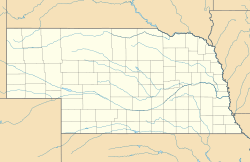Bordeaux Trading Post facts for kids
Quick facts for kids |
|
|
Bordeaux Trading Post
|
|

Reconstruction, at Museum of the Fur Trade
|
|
| Location | Three miles east of Chadron on U.S. 20 |
|---|---|
| Nearest city | Chadron, Nebraska |
| Area | 1.5 acres (0.61 ha) |
| Built | 1846 |
| NRHP reference No. | 72000746 |
| Added to NRHP | March 16, 1972 |
The Bordeaux Trading Post is a historic site near Chadron, Nebraska. It was built between 1845 and 1846 by a man named James Bordeaux. Today, the trading post has been carefully rebuilt in its original spot. It even uses old wood from a nearby ranch to look just like it did long ago. This special place is now known as the Museum of the Fur Trade.
In 1972, the Bordeaux Trading Post was added to the National Register of Historic Places. This means it's a very important historical site. Experts believed it could still offer valuable information about the past.
Contents
History of the Trading Post
The Bordeaux Trading Post stands on the museum grounds today. It was rebuilt in 1956 on its exact original foundation. The storehouse was also reconstructed soon after. People in the 1950s knew where the post used to be. They saw a large dip in the ground near Bordeaux Creek.
Finding the Original Spot
Eyewitnesses helped find the exact location. Hudson Mead, the first county surveyor, and Welcome Naylor, whose father was an early settler, had seen the old ruins in the 1880s. Even more helpful were Herbert and John Bissonette. They were the sons of Joseph Bissonette, another fur trader. Joseph had a trading post nearby in the 1870s. His sons had visited Bordeaux's post many times when it was still open. Their descriptions of the inside, like where shelves and windows were, helped a lot. Archeologists later found proof that their memories were correct.
Rebuilding the Post
When they dug up the site, the old wooden walls and supports were found. But the wood was too old to be used again. Early settlers had even taken stones from the chimney. However, the original hearthstones of the fireplace and the entry steps were still there. These stones were first placed in 1837. The new walls are made of wood cut by hand. They follow the exact lines of the old walls. All the new support posts fit into the original holes. It's rare for a rebuilt structure to be on the National Register of Historic Places, but the Bordeaux Trading Post is.
Starting the Fur Trade Business
The trading post first opened in the fall of 1837. It was set up by Frederick Laboue, a trader for the American Fur Company. The company had just bought Fort Laramie, which was about 100 miles (160 km) away. Laboue wanted to trade more buffalo robes. So, he decided to open smaller posts in valleys where Native American tribes spent the winter. He chose Jim Bordeaux to manage this new post. Jim Bordeaux was married to two sisters from the Brulé Sioux tribe. One of his brothers-in-law, Swift Bear, was a chief.
Changes Over Time
The U.S. Army bought Fort Laramie from the fur company in 1849. This was during the time of the California Gold Rush of 1849. After this, Bordeaux started his own business. Sometimes, Crow Indians from Montana would raid his post on Bordeaux Creek. Friendly Sioux warriors, led by Red Leaf and Two Strikes, would chase them. They fought a battle about 25 miles (40 km) west at a place now called Crow Butte.
Bordeaux became successful. He eventually ran a store and a ranch near Fort Laramie. He also had a ranch in Wyoming. He helped as an interpreter during the Fort Laramie Treaty of 1868. His son, Louis, often managed the Bordeaux Creek post in later years. After the American Civil War, things were difficult on the Northern Plains. Trading often involved goods that were not allowed, like weapons. These were sometimes traded to Native American groups who were resisting government efforts to move them to reservations. In 1872, Jim Bordeaux left his businesses in the west. He moved to Fort Randall on the Missouri River. There, he had contracts to supply the army with things like hay and firewood. He passed away in 1878 at 64 years old.
The Post's Final Years
After Bordeaux left, Francis Boucher took over the post on Bordeaux Creek. Boucher was the son-in-law of Spotted Tail, a main chief of the Brulé Sioux. Boucher continued trading goods at the post. During this time, there were many conflicts between Native American groups and the army. In August 1876, army soldiers found Boucher with a large amount of ammunition. They stopped his business. The next year, the last free Native American groups either went to Canada or moved to permanent reservations. By the time the railroad and first settlers arrived in the Pine Ridge area in 1885, the post on Bordeaux Creek was in ruins.
In 1967, a special historical marker was placed on the museum grounds. It tells the story of the Bordeaux Trading Post. The Chadron Area Chamber of Commerce helped pay for it. Edgar Red Cloud, the grandson of Chief Red Cloud, gave a blessing and sang the Sioux national anthem at the ceremony.
See also



